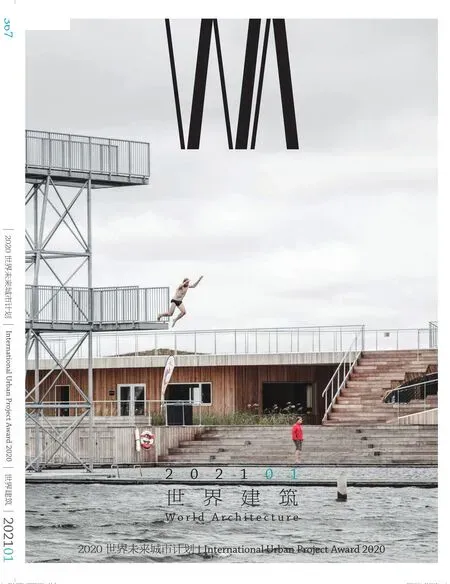未来非洲创新校区:发展非洲科学领导力,比勒陀利亚,南非
建筑设计:Earthworld建筑事务所
1 泛非洲研究中心
“该空间并非研究机构,至少不是传统意义上的研究机构,也无法把它简单视作一个校区……这是一个充满创意之地。未来非洲不仅是学科之间研究的中心,而且是跨学科研究的中心(前者着眼于学科之间的联系,后者是指‘两个或多个学科相互促进,形成一种新的整体研究’)。”
——伯纳德·史利珀斯
任务书提出要在非洲的大背景之下营造一片促进并加强跨学科研究的区域。该校区应成为关注科学领导力发展的集合性研究之地。
未来非洲创新校区将为来自各种文化背景的博士后学生提供一体化的生活工作环境,促进多样性文化及诸多学科之间的友谊、理解与协作。非洲学者分散居住的现状使跨学科研究受到很大阻隔,这也连带导致了极富价值的知识信息的流失。
校区包括280个居住单元(一居室、两居室和三居室)、一个中央大厅(未来非洲中心)、几个共用的研究空间及会议设施(包含一个250座的礼堂、两个50座的多功能厅和6个与礼堂相连、可兼做翻译间的休息室)。
“我们不能用制造问题的思维方式来解决问题。”
——阿尔伯特·爱因斯坦
未来非洲不仅关乎地点(所在地、意义),也关乎空间(建筑),更关乎建筑对其发展所处的生态环境所能做出的促进作用。
2 核心理念
2.1 开放性建筑、分解、三级系统和适应性
为使得离场制造与现场组装能够并行,我们有意将项目的体系与构造分解开,将一、二、三级系统进行整合并深化至家具设计的细节层面。为适应个性化需求,这些系统灵活、适应性强且促进使用者交互。
其构造还体现了耐久等级。混凝土和砖石等一级结构需用重型设备施工,钢材及可后期定制的装配材料等二级结构则需要轻型设备,第三级结构系统完全由使用者或非技术性工人手工组装,且结构具有未来适应性。
第三级系统主要由木材构成。胶合板和单板层积材被数字化地转换为拼接碎块,然后运送到现场,由非技术性工人在现场手工组装。
这个开放性的建筑不仅考虑到了适应性再利用和再循环,且承包方式更具选择性和包容性。这使该行业向较小众的“参与者”和非技术性劳动者敞开了大门。未来非洲中心是由9名非技术性工人组装的,所有构件元素都控制在了可以手工操作的尺寸,钢构件都有特定的重量限制以方便工人携带。
2.2 再生设计与催化开发
将建筑分解为界定清晰的构件元素提供了一种将制造外包给小微企业的可能性。构件的精度与一体化由数字建构领域的建筑师完成。装配由非技术性工人在现场完成。这种对小型企业的调动对于失业率较高的经济体将产生很大影响。
设计的目的不仅是为了简化对承包方的管理,也是为了建构新型产业或微型企业,这些业态可通过社区银行筹集资金。新的小型工厂或企业利用数字化策略来缩小他们与正式培训和市场准入门槛之间的差距。也就是说,教会一个工人操作数控机床要比培养一个熟练的木工容易得多。
非正式体系在发展中社区早已存在,如能通过质量控制和适度调节来扩大其应用,就能建立一个全新的民主工业化领域。
2.3 施工的民主化
开放建筑工业使小微企业能够参与建构大型项目是本项目的关键。负责制造和安装第三级系统的承包方中,没有一家从事过类似尺度的项目工作,也没有一家生产过任何类似的构件。使用基础架构成熟的企业无疑风险更低,但这些工业化机构逐渐增加的成本及其僵化程度既有碍于创新,也无法提供有意义的联动机会。
小型承包方的所有权程度为其带来了极大的自豪感、意义和成就感。自工业革命将劳动力视做商品以来,我们的行业早已失去了上述特质。
2.4 并行价值链与线性价值链
我们有意运用地方性的技术手段,而非已建立的、高度专业化的、引进的建筑体系。所有材料都在现场或场地附近直接加工。除铝合金窗和机械、电气、电子设备外,所有构件都在距场地20km的范围内生产完成。将不同制造商的生产进行整合,在安装之前只需处理一次材料,这种方式削弱了线性价值链的必要性。
2.5 系统思维/互联性
该项目不仅作为空间、居住和庇护所存在,也是以人为本的体系的核心。第一、二、三级使用者都参与到了生态系统的构建当中。地方经济、生态和景观的融合是该项目的重中之重。项目及其在构建过程中的影响与最终落成结果同等重要。
3 结语
发展过程中,区域环境如要达成社区、所有权、多方参与及理念一体化的建构结果,则需通过空间透明性、民主化和决策加以实现。大学中,将共享设施建筑群置于住宅单元的中心位置是惯例,但这仍然形成了“中岛”与“隔离”的情况。对平面形态的二次构想是设置一个集中性的交互空间,该设计策略能促进合作、促进文化互动和友谊。协作/公共设施的中心是餐饮和准备区。出于文化多样性的考虑,围绕“餐桌”分享想法是此种组织模式的核心。我们在校园异地种植了56种孤生农作物,使用者可自发探寻食材。这些关于新口味、口感和食材搭配的创造性互动使得景观设计也成为了整体系统的一部分。(安德烈·埃克斯廷 文,天妮 译)
1 A Pan-African Research Centre
"This space is not an institute, at least not in the traditional sense. Nor can you consider it a campus...... it's a place animated by ideas. Future Africa is designed to be a hub not merely for interdisciplinary research, but trans disciplinary research. (While the former looks at the nexus between disciplines, the latter refers to "two or more disciplines transcend[ing] each other to form a new holistic approach)". -Prof. Bernard Slippers
The brief called for the design of an environment that would facilitate and enhance trans-disciplinary research within the African context. The facility should be a place where collective research is done with a strong focus on science leadership development.
Future Africa is to provide an integrated live-/work environment for post-doctorate students from all cultures and backgrounds; fostering fellowship, understanding and collaboration among the vast diversity of cultures and disciplines on our continent. The diaspora of African academics has left scientists isolated. This often leads to discouragement and subsequent loss of valuable knowledge.
Its facilities include: 280 one-, two-, and 3 bedroom living units, a central hall (Future Africa Hub), several research commons, and conference facilities which consist of one 250-seat Auditorium,two 50-seat Multi-purpose Rooms, and 6 Break-away Rooms, linked to the Auditorium; also doubling up as Translation Booths.
"We can't solve problems with the same kind of thinking we used when we created them". -Albert Einstein.
Future Africa is not only about place (locality,meaning) nor space (building), but also about the contribution a building can make to the ecology within which it is developed.
2 Key Concepts
2.1 Open Building, Disentanglement, Primary,Secondary, Tertiary Systems, Adaptability
Systems and tectonics were deliberately disentangled to allow for parallel off-site manufacture and on-site assembly. Primary,Secondary and Tertiary systems were integrated all the way down to the detail level of furniture design, which were flexible and adaptable requiring user interaction to suit each individual's requirements.
The levels of permanence can also be read in the tectonics. The primary (concrete & masonry)required heavy equipment through to the secondary structures (steel also accommodating post-fitted services) required lighter equipment and the tertiary systems being completely hand-assembled by either the user or unskilled labour. Allows for future adaptability.
Timber was used extensively for the Tertiary systems. Plywood and LVL were digitally "converted"into puzzle pieces. Then brought to site and hand assembled by unskilled labour on site.
Not only does this Open Building allow for adaptive re-use and re-cycling, it also allows for alternative, more inclusive contracting. This opens up the industry to smaller "players" and unskilled labour. The Hub Building was assembled by 9 previously unskilled labourers. Elements were all kept to a scale which can be handled by humanhand. Steel elements were designed within speci fic weight restrictions to allow elements to be carried by labourers.
2.2 Regenerative Design/Catalytic Development
Breaking the buildings down in clearly de fined elements offers the potential of outsourcing manufacture to small and micro enterprises. The tolerances and integration of elements is done by the architect in the digital realm. Assembly is done by unskilled labour on site. The catalytic nature of mobilising these micro enterprises can be highly impactful on an economy with huge unemployment.
Design, not to simplify the management for the contractor but, to allow for the establishment of new industries and micro enterprises which can be funded by community banking; new small factories or Buros utilising digital tools to close the gap between formal training and market access, i.e. it is easier to teach someone to operate a CNC machine than to train a master carpenter.
Informal systems in the developing communities already exist; if these can be augmented with quality control and moderation a whole new sphere of democratised industrialisation can be established.
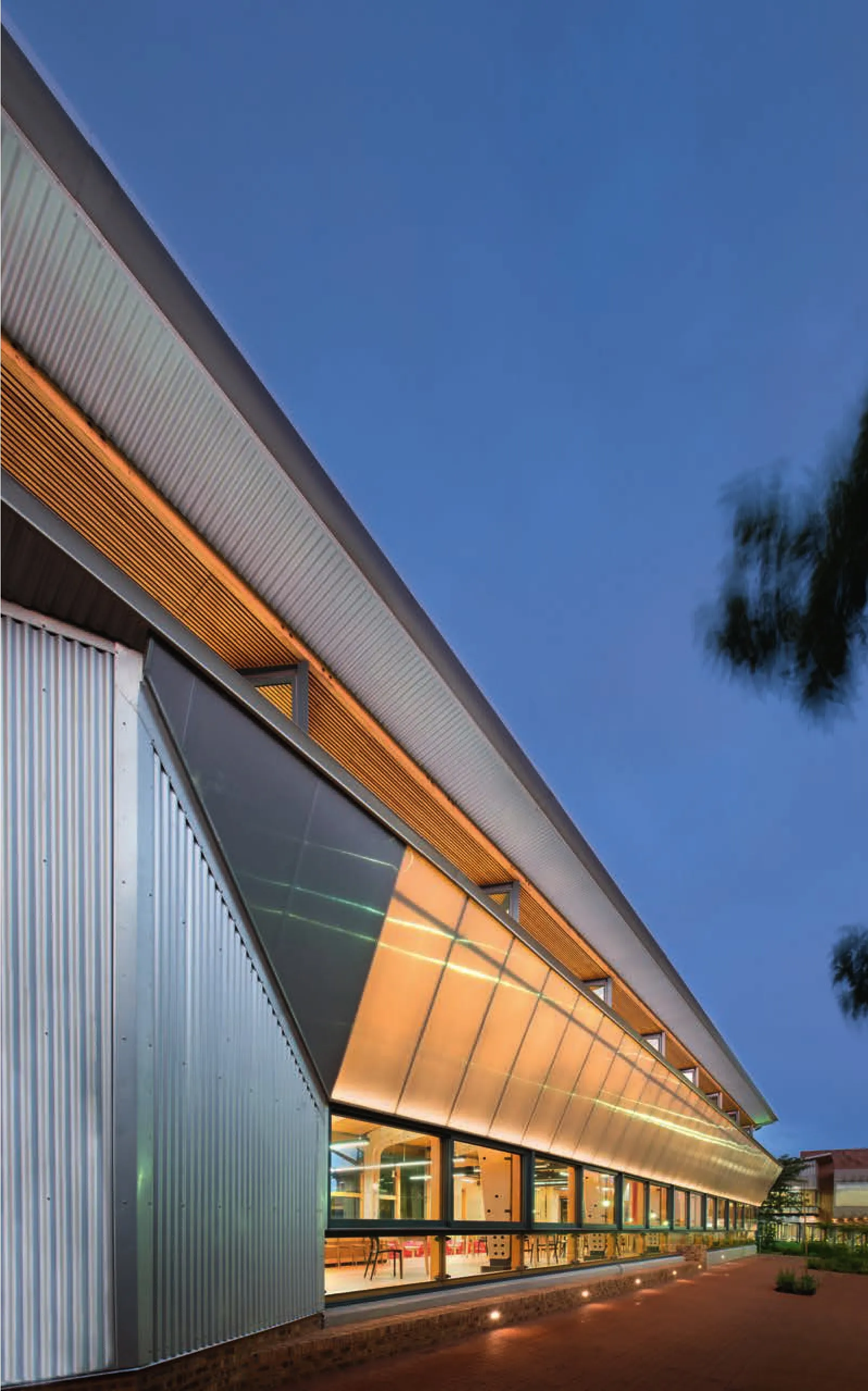
1 未来非洲中心外景/Exterior view of Hub

2 校区鸟瞰/Aerial view of campus
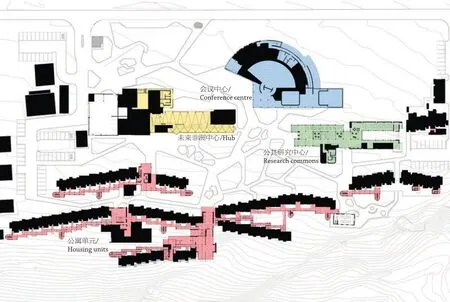
3 校区平面/Campus plan
2.3 Democratisation of Building
Opening the building industry up to allow for small and micro enterprises to participate in large projects is key to the project. Not one of the contractors responsible for the manufacture and installation of the tertiary systems have ever worked on this scale, nor have they produced anything of this nature. Using companies with established infrastructure are seen as low risk but the increased cost and rigidity of these industrialised organisations do not allow for innovation nor does it provide the opportunity for meaningful associations.
The level of ownership taken on by the small contractors resulted in immense pride, meaning and a sense of accomplishment; traits that has been lost to our industry since the industrial revolution when labour were reduced to commodity.
2.4 Parallel vs. Linear Value/Supply Chains
We deliberately curated local skills rather than using established highly specialised imported building systems. All materials were sourced directly with processing taking place on or close to the site. Apart from the Aluminium Windows and the Mechanical, Electrical and Electronic equipment,no manufacture were done further than 20 km from site. Integrating the production of the various manufacturers negated the need for linear value chains by material being handled only once before installed.
2.5 Systems Thinking/Inter-connectedness:
The building is not only space, accommodation and shelter but, central to a system where people are key. Primary, secondary and tertiary users all get to participate in the success of the ecosystem. Integration of the local economy, ecology and landscape was critical parts of the project. The project and the impact during construction is just as important as the final product.
3 Close
The environment resulting from the development must foster community, ownership, participation and thought integration through spatial transparency, democracy and choice. Conventional approach at universities call for clusters of buildings with some shared facilities central to the residential units. These still created islands and isolation. The re-imagining of this typology called for centralised spaces for interaction; these would facilitate collaboration, cultural interaction and friendship.Central to the collaboration/communal facilities are food and the preparation there off. With the vast cultural diversity on our continent the idea of sharing thoughts around "dinner tables" was core the organisation. The landscape design also formed part of the system by re-introducing 56 orphan crops and allowing foraging to explore alternative cuisines and creative interaction around new tastes,textures and colours. (Text by André Eksteen)
项目信息/Credits and Data
地点/Location: Future Africa, 40 South Street, Hillcrest Campus (Experimental Farm), University of Pretoria,Hillcrest, Pretoria, South Africa
客户/Client: University of Pretoria, Future Africa
建筑设计/Principal Architects: Earthworld Architects cc
设计团队/Design Team: Arné Gunter, Petri van Wyk,Madelaine Haycock, Christian Greyling, Erika Theunissen
项目负责人/Principal-In-Charge: André Eksteen
项目团队/Project Team:
结构工程/Structural Engineers: WSP
机械设计顾问/Mechanical Design Consultant: Acend
电气承建/Electrical Contractor: DSP Consulting, Harm Boer
景观设计/Landscape Architect: InSite
工程测算/Quantity Surveyor: VSB Quantity Surveyors cc
顾问/其他专业/Consultants/Other Specialists:
电气工程/Electronic Engineers: Delportdupreez
可操作性原则是指为设计需要而设计的监控系统,以保证系统的可操作性,各建筑的管理工作的管理体系是不同的,管理的技术能力和水平的管理是不均衡的,而且并不是所有的管理者都通过我的教育专业技术培训,一些管理者的素质和能力以及技术水平都很低,所以在安全系统设计时必须注意各种形式的操纵,确保每个管理者都能有效的安全监控管理系统的运行。
土木工程/Civil Engineers: Aurecon
给排水/Wet Services: BVi
项目管理/Project Managers: MDSA, SPE
地质工程/Geotechnical: Verdicon
消防顾问/Fire Consultant: Chimera
健康与安保/Health & Safety: NCC
钢结构承建/Steel contractor: A-Leita Steel
木结构/Structural Timber: The Woodsman
细木工/Joinery: Funkt
细木工衔接/Joinery CC: NuHome
遗产保护/Heritage: West Rand Heritage Consultants
承建/Contractor: JC van der Linde & Venter Projects
基底面积/Footprint: 7989.16 m²
总建筑面积/Total Floor Area: 24,015 m²
建筑使用面积/Net Floor Area: 12,673 m²
造价/Cost: 3850万南非兰特/385M ZAR
设计时间/Design Period: 2014.06-2015.10
施工时间/Construction Period: 2015.11-2018.11
摄影/Photos: Dook Photography (fig.1-4,6,7,11), Mighty Fine Production (fig.2), Lourens Uitenweerde - Eyescape Photography ( fig.5,10)

4 从会议中心看公寓/Viewing Housing Units from Conference Centre

5 公寓外景/Exterior view of Housing Units

6 未来非洲中心内景/Interior view of Hub
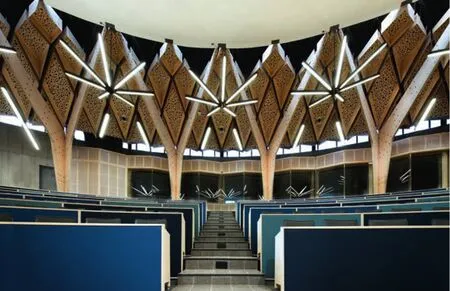
7 会议中心内景/Interior view of Conference Centre

8 未来非洲中心剖面/Section of Hub

9 会议中心剖面/Section of Conference Centre
评委评语
谢尔盖·卓班:未来非洲创新校区的综合功能包括了一个餐厅、一个会议中心、一栋研究楼和280个从单间到家庭套房的不同规模的居住单元。该项目利用了当地的材料和资源,它的美学设计及其多功能的品质既是差异化的,又保持了一致性和独特性。建筑的各个方面都与公共空间和公共活动相联系,并支持研究人员和居民之间的互动。(庞凌波 译)
Jury Statement
Sergei Tchoban: The complex programme of the Future Africa Innovation Campus includes a dining hall, a conference centre, a research building and 280 living units of varying scale, ranging from single bedrooms to family units. The project convinces with its use of local materials and resources, its differentiated, yet consistent and unique, aesthetic design as well as its multifunctional qualities. All aspects of the architecture are connected to public space and common activities and support interaction between researchers and residents.
曹嘉明:未来非洲创新校区是区别于传统校园建筑而具有强烈地域特征的开放性创新之地。围绕中央大厅和公共会议研究设施组成的280个生活单元,加强其相互之间的交流与协作,创造便利和共享交流的空间,同时对基地的生态环境给予了足够的重视。该项目另一特点是轻量化,鼓励参与者共同建造的建筑建造过程,同时对建筑材料审慎地可循环利用,突出了环保和绿色建造理念。
CAO Jiaming: Future Africa Innovation Campus is a place of open innovation with a strong regional identity that distinguishes it from traditional campus buildings. The 280 living units, which are organised around a central hall and public conference and research facilities, enhance communication and collaboration, and create spaces for convenient exchange and collaboration, while adequate attention is given to the ecological environment of the site.This project is also characterised by a lightweight building construction process that encourages the participants to build together, and by carefully recycling building materials, it highlights the concept of environmentally friendly and green construction.(Translated by PAN Yi)

10 公共研究中心外景/Exterior view of Research Commons
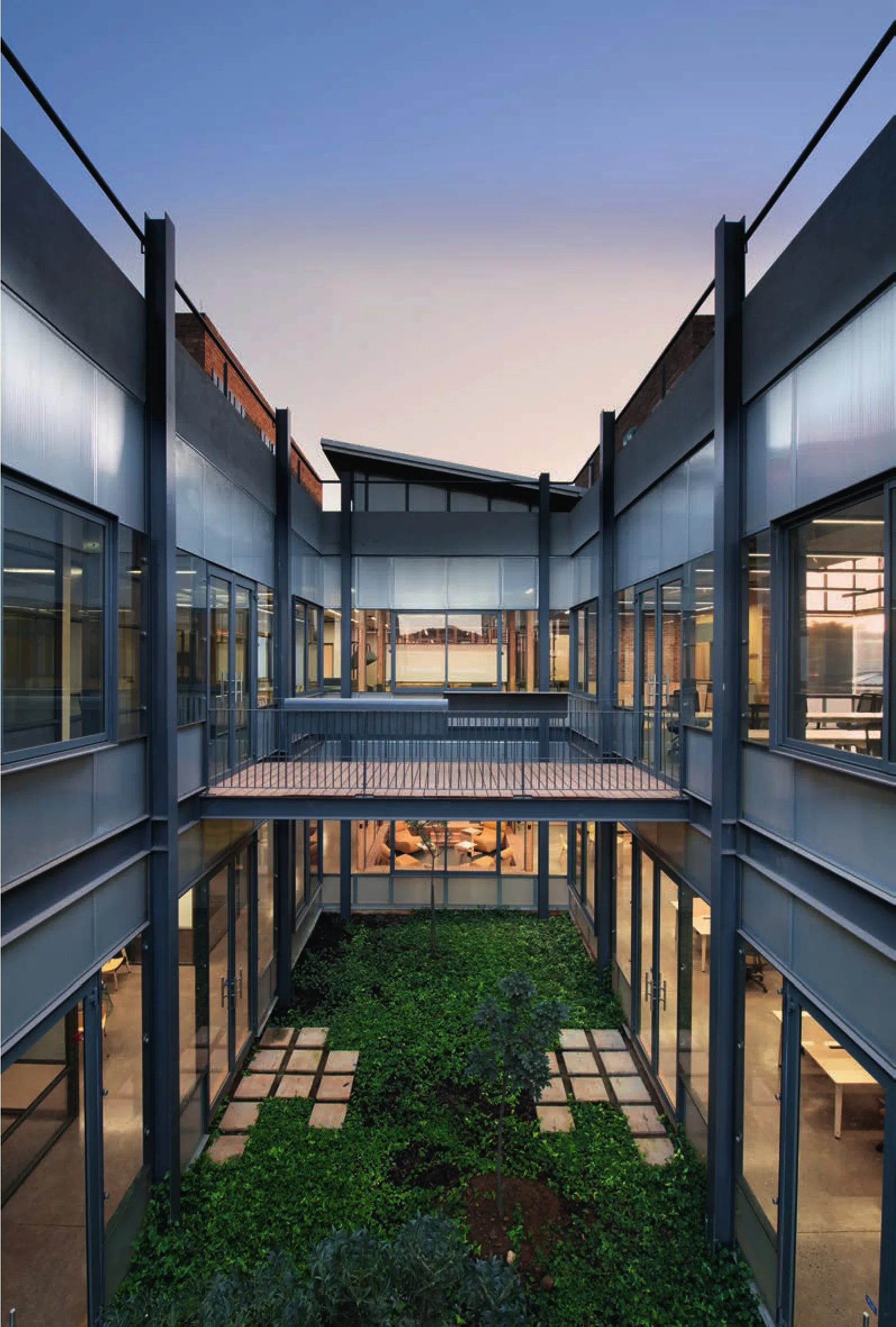
11 公共研究中心庭院/Courtyard of Research Commons

